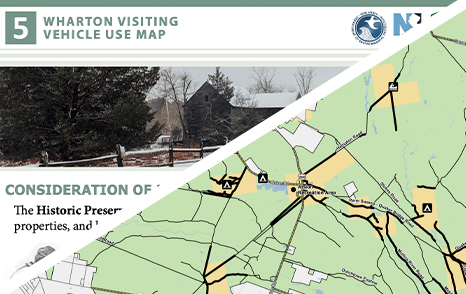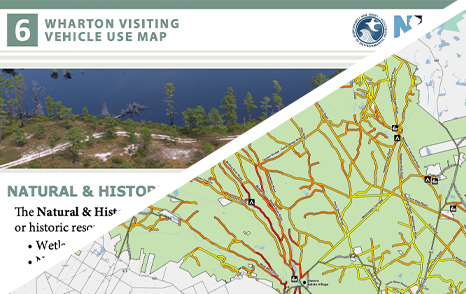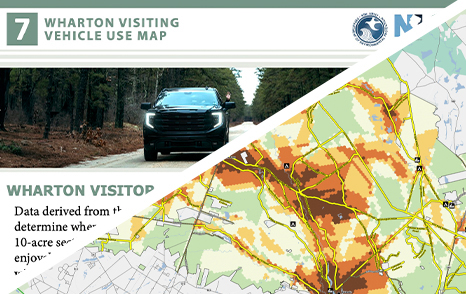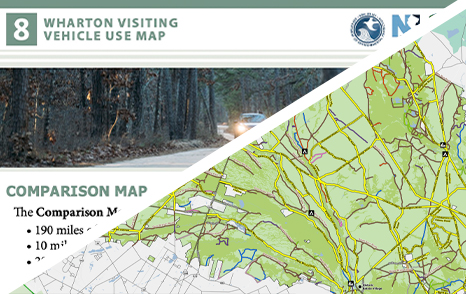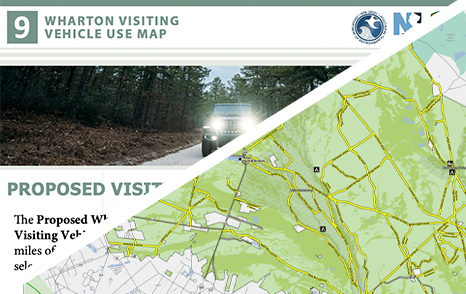A: N.J.A.C. 7:2 – Subchapter 3. Motorized Vehicles
N.J.A.C. 7:2-3.1 Identification and license
(a) A person shall not operate any motor vehicle on lands under the jurisdiction of the State Park Service or on established roads under the control of the State Park Service unless the vehicle is properly licensed and registered before it is operated.
(b) A person shall not operate any motor vehicle on lands under the jurisdiction of the State Park Service unless the operator of the motor vehicle shall have in his or her possession a valid operator's license and other documentation required by the New Jersey Division of Motor Vehicles.
N.J.A.C. 7:2-3.2 Unauthorized motor vehicle use
(a) A person shall not operate any motorized vehicle which does not require licensing and registration by the New Jersey Division of Motor Vehicles, on lands and waters under the jurisdiction of the State Park Service unless a permit for operation of said motorized vehicle is issued by the Director of the Division of Parks and Forestry or the Assistant Director of the Division for the State Park Service.
(b) Any permit granted pursuant to (a) above shall include designated hours and specific locations for operation.
(c) A person shall not operate a motor vehicle upon the ice-covered waters under the jurisdiction of the State Park Service at any time except for the operation of snowmobiles on routes designated by the State Park Service.
(d) A person shall not operate a motor vehicle upon State Park Service property while knowingly allowing any person riding upon any bicycle, coaster, skates, sled, skis, sliding device or toy vehicle to attach the same or himself to the motor vehicle.
(e) Except in accordance with N.J.A.C. 7:2-3.4(d), a person shall not operate or permit the operation on or over lands or in or on waters under the jurisdiction of the State Park Service of a motorized vehicle likely to cause damage or injury to persons, wildlife, or property within the jurisdiction of the State Park Service. Such vehicles include, but are not limited to, a motor vehicle with more than two axles or having tires larger than 40 inches in overall diameter, an ATV, or an unlicensed or unregistered motor vehicle.
N.J.A.C. 7:2-3.3 Conformance to State laws
All motor vehicles operated on lands under the jurisdiction of the State Park Service shall be subject to Motor Vehicle Laws of the State of New Jersey, N.J.S.A. 39-1 et seq., all rules promulgated pursuant thereto, and this chapter.
N.J.A.C. 7:2-3.4 Restriction on operation of motor vehicles
(a) A person shall not operate any motor vehicle on or over any lands under the jurisdiction of the State Park Service except on established public roads or in designated parking areas unless allowed otherwise by posted signs or this subchapter.
(b) A person shall not operate a motor vehicle at any time on or over any road designated closed by signs or barriers.
(c) A person shall not operate a motor vehicle on or over any cultivated or planted area, transmission line, survey line or in the woods, swamps, bogs, wetlands or fields unless a permit for said specific activity and location is issued by the Superintendent or designee.
(d) A person shall not operate an off-road vehicle on or over the lands and waters under the jurisdiction of the State Park Service at any time except that, when an area is so designated by the State Park Service, permits may be granted for organized "special events" to operate on a pre-established course under prescribed conditions.
(e) A person or organization shall not conduct a motor vehicle race, rally, exhibition or demonstration of any type on State Park Service lands and waters without a permit issued by the Superintendent or designee.
N.J.A.C. 7:2-3.5 Snowmobiles
(a) All use of snowmobiles on lands and frozen waters under the jurisdiction of the State Park Service shall be in conformance with N.J.S.A. 39:3C-1 et seq., the Motor Vehicle laws of the State of New Jersey, the rules promulgated pursuant thereto, and this chapter.
(b) Snowmobiling is only allowed on areas and trails specifically designated for that purpose.
(c) Snowmobiles shall not be operated in a reckless or careless manner or at speeds which are dangerous to persons and/or property.
(d) A person shall not operate a snowmobile while under the influence of intoxicating liquors, narcotics, or hallucinogenic or habit forming drugs.
(e) All accidents involving personal injury or damage to property shall be reported to the Superintendent and law enforcement personnel of the State park at which the accident occurred as soon as possible after the occurrence.
(f) Any race, rally or organized snowmobile activity shall require application for a use permit and/or scheduling at least five days in advance with the Superintendent or designee having jurisdiction over the property to be utilized. The application or request may be denied for reasonable cause.
(g) A person shall not fail or refuse to stop when ordered to do so by authorized enforcement personnel.
(h) On Lake Hopatcong, no snowmobiles shall be operated in excess of 15 miles per hour before 12:00 noon on Sunday.
N.J.A.C. 7:2-3.6 Motor vehicle speed limits
(a) A person shall not travel by motor vehicle on improved roadways under the jurisdiction of the State Park Service at a speed greater than 35 miles per hour unless otherwise posted.
(b) A person shall not travel by motor vehicle on unimproved (dirt, gravel or sand) roadways at a speed greater than 20 miles per hour unless otherwise posted higher or lower.
N.J.A.C. 7:2-3.7 Parking
(a) A person shall not park any motor vehicle, conveyance or other equipment except in areas designated for parking.
(b) A person shall not park any motor vehicle, conveyance or other equipment so as to block or impede traffic on roadways or paths.
(c) Parking shall be strictly confined to areas designated for that purpose. Temporary parking areas designated by the Superintendent or designee may be used to accommodate special functions.
N.J.A.C. 7:2-3.8 Traffic direction
Operators of all motor vehicles, bicycles, equestrians, and pedestrians shall comply with all traffic signs and signals and direction by voice, hand or whistle by duly authorized personnel.
N.J.A.C. 7:2-3.9 Motorized bicycle restrictions
(a) Motorized bicycles which meet the provisions of this subchapter are permitted on State Park Service roadways unless otherwise posted.
(b) In the interest of safety, the Superintendent or designee is authorized to temporarily prohibit or limit the operation of motorized bicycles.
(c) A person shall not operate a motorized bicycle on any right-of-way of any operating railroad.
(d) A person under the age of 15 years shall not operate a motorized bicycle on State Park Service property.
(e) A person shall not operate a motorized bicycle unless the operator is in possession of a valid drivers license or a motorized bicycle license, a valid registration, a valid insurance identification card and displays a valid license plate. Non-resident motorized bicycle owners shall be required to have complied with registration and licensing laws of the operator's state and shall obey all other State Park Service and New Jersey motor vehicle and traffic laws.
(f) State Park Service rules applicable to bicycles shall apply whenever a motorized bicycle is operated on State Park Service property.
(g) A motorized bicycle shall carry only the operator.
(h) A person shall not operate a motorized bicycle unless the operator wears a protective helmet of a type approved by the New Jersey Division of Motor Vehicles.
N.J.A.C. 7:2-3.10 Motorized scooters
A person shall not operate a motorized scooter on any lands under the jurisdiction of the State Park Service, including improved or unimproved roads, walkways, and parking areas.
 Official Site of The State of New Jersey
Official Site of The State of New Jersey








